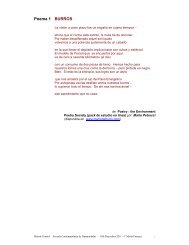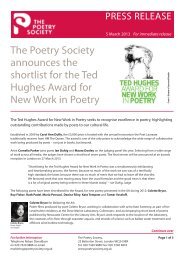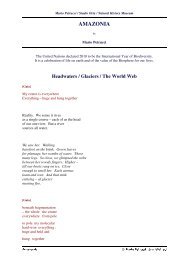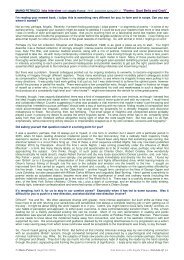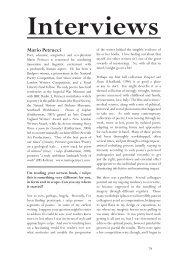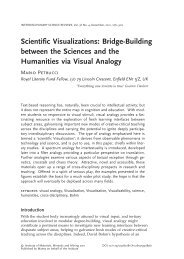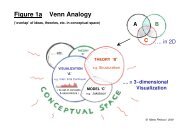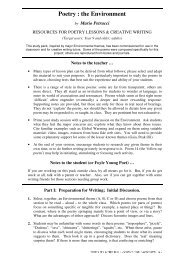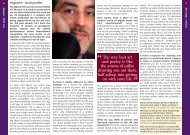poetry in performance: intertextuality, intra-textuality ... - Mario Petrucci
poetry in performance: intertextuality, intra-textuality ... - Mario Petrucci
poetry in performance: intertextuality, intra-textuality ... - Mario Petrucci
You also want an ePaper? Increase the reach of your titles
YUMPU automatically turns print PDFs into web optimized ePapers that Google loves.
References and Notes.<br />
[1] <strong>Mario</strong> <strong>Petrucci</strong>, ‘Poetry Workshops - Sea-change or Algal Bloom?’. Agenda (W<strong>in</strong>ter/Spr<strong>in</strong>g 1998, Vol.<br />
35/4 + 36/1, comb<strong>in</strong>ed issue; p.42). Also the <strong>in</strong>terview <strong>in</strong>: Magma (W<strong>in</strong>ter 2001, issue 19, p.46).<br />
[2] This paper has its roots <strong>in</strong> the presentation I made at the NAWE Conference on Re-Writ<strong>in</strong>g, 25 November<br />
2000 at Oxford Brookes University, where the key ideas were set out. Some of these ideas have been<br />
followed up and reproduced <strong>in</strong>: “Public Poems: Performance Poems without the Performer?”, NAWE<br />
Higher Education Forum, <strong>in</strong>: www.NAWE.co.uk, issue 2 of ‘The Creative Writ<strong>in</strong>g <strong>in</strong> Higher Education<br />
Journal’, Autumn 2001.<br />
[3] Alan Rob<strong>in</strong>son, ‘Instabilities <strong>in</strong> Contemporary British Poetry’ (Bas<strong>in</strong>gstoke; Macmillan, 1988) p.8.<br />
[4] Ian Gregson, ‘Contemporary Poetry and Postmodernism: Dialogue and Estrangement’ (Bas<strong>in</strong>gstoke;<br />
Macmillan, 1996).<br />
[5] Rob Pope, ‘Textual Intervention (Critical and Creative Strategies for Literary Studies)’, Routledge<br />
(London, 1995). Pope’s deployment of the term ‘Re-Writ<strong>in</strong>g’ is my primary reference po<strong>in</strong>t for its<br />
mean<strong>in</strong>g.<br />
[6] Although Ian Hamilton is disparag<strong>in</strong>g about the trend, he lends weight to my sense of a k<strong>in</strong>d of fluidisation<br />
<strong>in</strong> contemporary <strong>poetry</strong> when he notes (Poetry Review 87/4, 1997/8): “I do feel that <strong>poetry</strong>’s become more<br />
of a rag-bag - more <strong>in</strong>clusive… more discursive, more of a receptacle for amus<strong>in</strong>g observations” (p. 29) and<br />
“The drift of <strong>poetry</strong> has been to make itself like other th<strong>in</strong>gs <strong>in</strong> order to w<strong>in</strong> audiences or to keep itself<br />
alive” (p.30).<br />
[7] For more on Bakht<strong>in</strong>: David Lodge, ‘After Bakht<strong>in</strong>’ (Routledge, 1990) and ‘The Art of Fiction’ (Pengu<strong>in</strong>,<br />
1992).<br />
[8] There is more on the emphasis on poems rather than poets <strong>in</strong>: <strong>Mario</strong> <strong>Petrucci</strong>, ‘Born, Made, Or Thrust<br />
Upon Us?’ (Envoi 123, June 1999, pp. 46-48). Poem-centred anthologies and collaborations are also<br />
touched upon <strong>in</strong> this essay.<br />
[9] Jo Shapcott & Matthew Sweeney (eds.), ‘Emergency Kit: Poems for Strange Times’ (London; Faber,<br />
1996) p. xvi.<br />
[10] Clark and Holquist, quoted <strong>in</strong> (1990) [7], p. 96.<br />
[11] David Kennedy, ‘New Relations: the Refashion<strong>in</strong>g of British Poetry 1980 - 1994’ (Bridgend; Seren Books,<br />
1996).<br />
[12] Ken Edwards, ‘Grasp<strong>in</strong>g the Plural’, <strong>in</strong>: Denise Riley (ed.), ‘Poets On Writ<strong>in</strong>g: Brita<strong>in</strong>, 1970—1991’<br />
(Bas<strong>in</strong>gstoke; Macmillan, 1992) p.27.<br />
[13] David Lodge (1990): see [7], p. 44.<br />
[14] A useful overview of Intertextual modes (such as ‘weak’ and ‘strong’) was provided by Rob Middlehurst,<br />
<strong>in</strong>: ‘New Tissues of Past Citations: Discussion Notes’, a handout presented dur<strong>in</strong>g his talk at the NAWE<br />
Conference on Re-Writ<strong>in</strong>g (Oxford Brookes University, November 2000).<br />
[15] The use of ‘strong’ and ‘weak’ for Inter<strong>textuality</strong> can also be found <strong>in</strong> Andrew Bennett and Nicholas<br />
Royle, ‘An Introduction to Literature, Criticism and Theory: Key Critical Concepts’ (Prentice Hall /<br />
Harvester Wheatsheaf, London /New York,1995). On p. 201the authors speak of: ‘… the strong sense of a<br />
text’s strictly unbounded capacity for referr<strong>in</strong>g to or l<strong>in</strong>k<strong>in</strong>g up with other texts.’ I f<strong>in</strong>d this use of ‘strong’<br />
unhelpful, a view I aired at the NAWE Conference and which I underscore here.<br />
[16] ‘Centripetal’ and ‘centrifugal’ have already been deployed <strong>in</strong> various ways (eg [4], p. 3). Gregson’s<br />
centrifugal relates to ‘estrangement’ whereby poets avoid association with any monologic world-view. I<br />
use the term more generally, for any writ<strong>in</strong>g that shrugs off the familiar so as to generate new/ hybrid forms<br />
(as <strong>in</strong> ‘Mutations’). But Gregson’s ‘estrangement techniques’ would certa<strong>in</strong>ly sit with<strong>in</strong> my term.<br />
[17] <strong>Mario</strong> <strong>Petrucci</strong>, ‘Shrapnel and Sheets’ (Headland Publications, 1996).<br />
17



